Mysterious face
Emmaten
The
noted Meiji period collector Hara Sankei formerly owned this work. It was
painted sometime in the 12th century during the Heian period, but the colors
are still surprisingly vivid. In that sense, the inherent beauty of Buddhism
during that period has been passed down to us in a most satisfying way. It
is thought that this was the central image of worship for an esoteric ritual
called Emmaten-hou. People of that time believed that there was an invisible
power that exerted itself on their lives and therefore prayed to this supernatural
force. In the Emmaten-hou service, there were precise votive offerings used
in the making of an altar, and requests and prayers were offered to the painting
in the hope of Emmaten's manifestation. Moreover, Emmaten has a longer history
than Buddha does. He was originally a god of classical Indian mythology, son
of the sun god, Vivasvat. Yama was the first person to die and go to the other
world on behalf of human beings where he discovered the Pure Land where the
inhabitants constantly performed celestial music.
Eventually, he became a king of that world. During
later periods, Yama was given the role of judging the dead and the other world
came to have an image similar to Hell. But, in this painting Emmaten has a
kind and mysterious expression, and his plump body and limbs emit a warm,
reddish glow.
The nonchalant gaze of the cow seems to evoke a power
that overflows with ancient wisdom.
The Emmaten will be exhibited from Tuesday, November
3, to Sunday, Novembe r 8, when the First Anniversary Exhibition will be open
to the public.
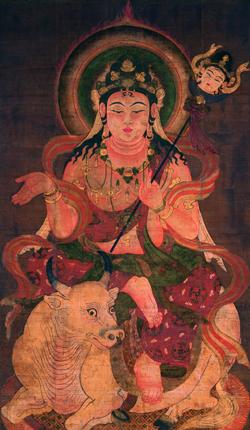
Emmaten
Late Heian period,
12th century
Hanging scroll, color and gold on silk
Height, 155.8cm; width, 84.5cm
Important Cultural Property
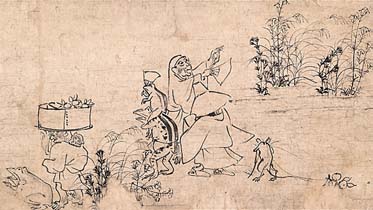
Frolicking Animals and Figures. (Fragment)
Hanging Scroll
Heian period, 12th century
A
variety of animals are personified in this fragment of a scroll painting from
the Kozan-ji Temple collection. The movements of the animals are portrayed
in a very lifelike manner, conveying the artist's affectionate treatment of
his subject. The swaying autumn plants in the gentle breeze is another highlight
of this Yamato-e master-piece. [November 3 through December 15]
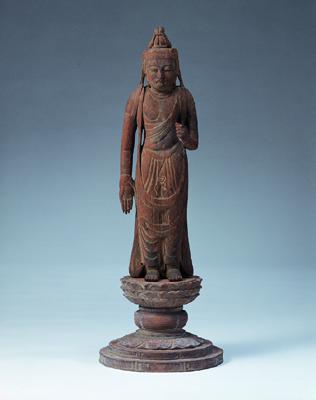
Standing Bosatsu
Heian period,
10th century
Single wood-block constriction
This
image is thought to represent Kannon Bosatsu(Sanskrit:Avalokitesvara) , and
with the exception of the fronts of both feet and the foot tenon, it has been
carved from a single piece of hinoki wood. The figure appears to have originally
been decorated with a thin coat of pigment. The extended fingertips stretch
down with the palm facing forward a gesture occasionally seen in the older
style images of the early Heian period. The round face, small nose, and slightly
elongated eyes and mouth create a reserved mood, reminiscent of the late 10th
century style produced by the Buddhist sculptor Kojo.
[September 1 through October
18]
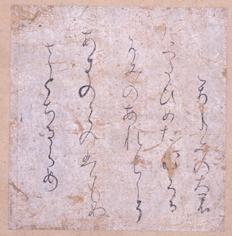
Poem on Shikishi Paper,
known as "Sunsho-an Shikishi"
Attributed to
Ki no Tsurayuki,
Heian period, 10th century
Toward
the end of his life, Sakuma Sanekatsu, a military commander who ser ved under
Shogun Ieyasu Tokugawa, retired to a teahouse called Sunsho-an at Ryuko-in
in the Daitoku-ji Temple. These twelve sheets of shikishi paper were among
Sanekatsu's most cherished possessions, which explains the work's title. An
autumn poem by Kanemi no Ookimi is written in an elegant hand on decorated
paper. Along with the "Tsugi shikishi", attributed to Ono Michikaze, this
work is of exceptional significance .
[November 3 through December
15]
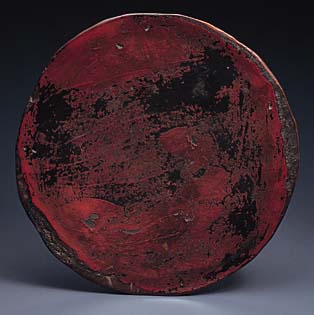
Large Tray
Muromachi period,
15th century
Red lacquered wood
A
slice of a large, old keyaki tree was carved with a yari ganna chisel in to
a round tray-shape with a slight depressoin. The top surface of the tray was
then coated with an underlayer of black lacquer which was then covered with
an overlayer of red lacquer. The areas of remaining plain wood show the marks
of a chisel, giving the work a free, unrestrained feel. After long years of
use and rubbing, the many layers of lacquer have worn to produce a superb
example of the rich surface texture known as Negoro. While the original use
of this tray is not known, it is said to have been handed down in the Todaiji
collections.
[September 1 through October
18]
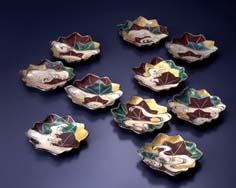
Set of Mukozuke Dishes
with Tatsutagawa Design
Kenzan ware, underglaze
and overglaze polychrome
Edo period, 18th century
Although
Kenzan studied the principles of ceramic craftsmanship under Nono mura Ninsei,
the great pioneer of Kyoto ceramics, his method of painting was quite different.
While Ninsei would paint a piece after applying a transparent glaze, Kenzan
devised a method that was exactly the opposite. First, he would lay the groundwork
by doing the painting, and later, he would apply the glaze. The result was
very striking. Although the shape of each is uniform with the others, the
variance of the autumn leaf and flowing water motif within each dish give
the viewer an overall impression of rhythmic vitality when looking at the
entire set. This set of dishes is considered to be among those most representative
of Kenzan's work.
[November 3 through December
15]